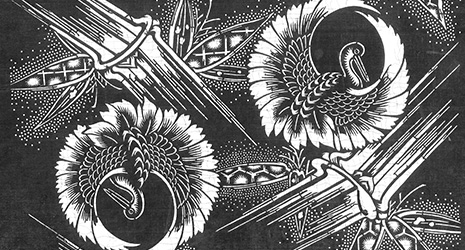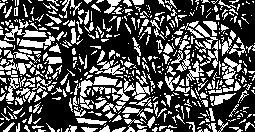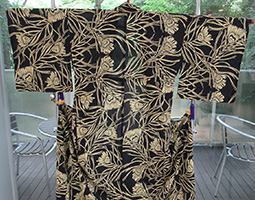December 2022
- English
- 日本語
The Ise-Katagami Patterns that Fascinated Europeans

Ise-Katagami stencil for a crane pattern 
Ise-Katagami stencil with numerous small, detailed patterns

Ise-Katagami stencil for a flowers and leaves pattern 
Ise-Katagami stencil for a bamboo and the moon pattern 
Ise-Katagami stencil for a carp pattern 
A kimono printed with an Ise-Katagami peacock feather pattern

“Katagami” refers to the traditional Japanese craft of stencils featuring fine patterns cut into washi paper. Vivid patterns emerge on kimono fabrics by dyeing the fabric using these stencils. Ise-Katagami, a well-known type of Japanese paper stencil, were brought to Europe in the first half of the 19th century and fascinated people there.

Katagami, or paper stencils, are used to print patterns on kimono fabric. These stencils have patterns drawn on and then cut out from washi paper processed with persimmon tannin*. Using the stencils, the pattern can be dyed onto fabric. Ise-Katagami from Mie Prefecture is a typical type of Japanese stencil, boasting a history of over 1,000 years.
Director Kajiura Genki of the Kioi Art Gallery (Edo Ise-Katagami Kimono Museum) in Chiyoda City, Tokyo, says that “those who saw Ise-Katagami surely were surprised at the artwork-like beauty and refinement of the stencils. Nevertheless, the names of the creators of the old paper stencils have not been handed down and remain unknown.”

Kajiura says that the reason for this is that “stencils are simply tools used to dye fabrics, and at the time, they were not recognized as works of art in themselves.”
Washi paper made from kozo** bark is used for Ise-Katagami. Three sheets are laid on top of one another and pasted together with persimmon tannins, with fibers running vertically, horizontally, then vertically. This technique creates a durable stencil that can be used multiple times for dyeing. Using special tools, artisans known as horishi delicately cut a variety of patterns based on traditional themes of natural beauty into the pasted-together washi paper.

For example, kiribori (drill carving) is used for komon, or small patterns, in which detailed patterns are spread out over the entire kimono fabric. In some cases, 100 small holes are cut into each 1 cm square. To complete these pointillist painting-like patterns, there is a need for not just a high level of skill, but also a tireless will not to become distracted. Kajiura says that “in recent years, mainstream print dyeing with machines can accurately and quickly print any design or pattern. However, one doesn’t feel the warmth or unique texture that comes from dyeing by hand. As a result, there is still a demand for dyeing using Ise-Katagami today, regardless of how much money or time it requires.”
The standard Ise-Katagami stencil is 38 cm wide and 25 to 38 cm long, with the width matching that of the fabric. When repeatedly arranged precisely in parallel, a beautiful continuous pattern can be printed on a roll of cloth (12 to 14 meters in length) needed for a single kimono. To dye the fabric, the stencil is first placed on the fabric and resist dyeing paste is applied. After applying dye to the fabric, the resist dyeing paste is washed away. The part covered by the paste is not dyed, and the pattern cut into the stencil appears on the fabric.

In the first half of the 19th century, German doctor and naturalist Philipp Franz von Siebold visited Japan, and upon return to his home, he took with him a large amount of Ise Katagami, along with ukiyo-e woodblock prints and specimens of the animals and plants he collected. This is how Ise-Katagami came to be known in Europe.
Kajiura says that “Siebold, who came across the Ise-Katagami, surely understood their value at first glance. Later, ukiyo-e spurred an enthusiastic vogue for Japonisme among Monet, Van Gogh, and other French impressionist painters. In the same way, Ise-Katagami also fascinated the European population and had a great influence on designs in various fields, including crafts, accessories, bags, wallpaper, and more. It seems that Ise-Katagami was used as the inspiration for glass, ceramics, furniture, and other crafts in France and as examples of stencils in craft museums and craft schools in Germany.”

The Kioi Art Gallery, an art museum specializing in Ise-Katagami, houses around 5,000 Ise-Katagami stencils mostly from the Edo period (early 17th to mid-late 19th century), and of those, around 200 are seasonally rotated and permanently exhibited alongside kimono that have been dyed with Ise-Katagami stencils. It is a place of great value where one can thoroughly admire the surprising refinement of the Japanese traditional crafts left behind by artisans.
- * A liquid squeezed from unripe, sour persimmons
- ** A deciduous shrub in the Moraceae (mulberry) family and a primary material for washi paper

